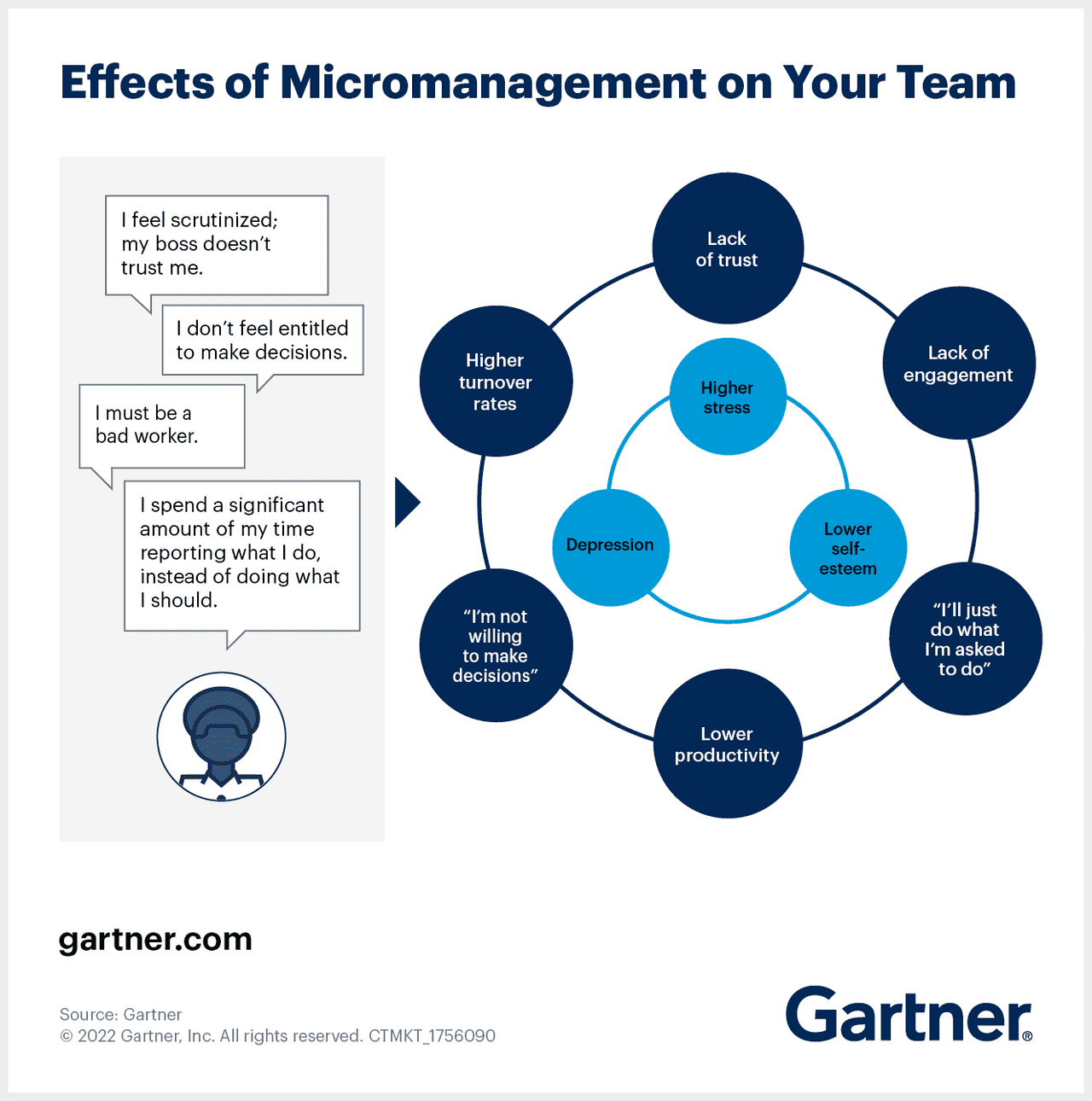Unleashing Team Potential: A Practical Guide to Overcoming Micromanagement
☕ 4 min read
Micromanagement can inadvertently stifle creativity, diminish team morale, and hinder growth. Recognizing and addressing these tendencies is crucial for fostering a thriving, engaged team. Here, we expand on Gartner’s recommendations, providing actionable steps to transform micromanagement into effective leadership
Gartner published a report in 2022 about remote work, micromanagment, and how to fix your approach. In this post I’m going to review the report, share my experiences, and provide a summary for myself for future reference.
5 questions to determine if you are a micromanager
Not sure whether you’re prone to micromanaging in the world of remote work? Ask yourself these questions:
- Do I often have concerns about or question (outspokenly or silently) employees’ productivity?
- Do I find myself constantly wanting to be informed of every bit of progress made?
- Do I peek into systems records to check that someone actually did what I asked?
- Do I find myself limiting others’ authority to keep myself engaged with initiatives?
- Do I find it difficult to delegate tasks because I don’t trust they will get done?
If you answered yes to any of these questions, then you’re likely a micromanager.
Gartner.com: Micromanaging Your Remote Workers? Own It, Then Fix It.
How to fix your approach to manangement
The following are recommendations by Gartner on how to fix your approach to manangement if you are a micromanager. I’ve expanded on what I think should be done in each case to “action” the recommendation.
Empower team members. Make sure team members all understand the impact and scope of what is expected of them, articulate how their activities are crucial to meeting enterprise goals and provide each with the resources they need to get the job done
- Sprint goals provide a team target to aim for and a plan for the sprint demo at the end
- Work with the product owner/manager to create a clear vision of the product the team is building and a detailed roadmap of how we get there
- Share Scrum Master and Tech Lead roles. Roles are a list of responsibilities, responsibilities can be shared, and they can be used to provide mentoring and learning opportunties for the whole team. Roles do NOT provide additional authority
Focus on outcomes. Don’t waste time obsessing over the time the team dedicates to getting the job done or how they do it. What matters is that they get results in the agreed-upon time frame
- Sprint demos allow teams to show what they have worked on. Product Manager/Project Manager/Scrum Master/Tech Lead/etc should NOT be the one to give the demo unless they actually worked on building it, let whoever brought it to life be the one to share it
- Measuring an individual’s productivity is not important, people have busy and stressful lives. How quickly one person can learn and apply their skills is different to another. The team should be supporting it’s members, not criticising or comparing them. This only creates a stressful environment
- Standups are for requesting support, not for tracking producitivity. Everyone on the team is busy, do not waste time telling everyone how busy you are. If someone needs help the standup is the perfect time to ask for help
Be flexible. Give people the opportunity to work when, where, and how they can be most creative and productive
- Flexible working hours allow people to handle personal committments when it suits them best. This is crucially important for a well functioning, and happy team
- Allow personal days to recharge, additional to PTO. As a manager you should be telling people to take personal days if needed, remind the team that they can take these days without it affecting their existing legally entitled PTO. It’s easy for team members to feel like they can’t take these days without consequence, be a good manager, remind the team often
Plan for the worst case. This makes people feel trusted and confident in their ability to handle problems
- When estimating work to fit in a sprint use the worst case estimate. If work turns out to be easier than expected its a win and will keep stress levels low. If the work turns out to take longer than expected then we get better at estimating and next time it’ll be more accurate. Do not put pressure on your team, or individuals, humans don’t work well under stress
Do not blame. Blame instantly crushes self-esteem and spoils the bonds of trust with your employees. Focus on lessons learned from failures. Let your team come up with the answer of what to do better next time
- Win as a team, lose as a team. When you reward individuals for the work of the entire team you severly damage team morale and trust. Damaging team morale is costly to an organisation, people will leave, or they will “silently leave” which means they will do the bare minimum to get by instead of working for themselves and the fun of it
- Do not escalate internal team issues without first discussing with specific team members. Encourage the team to talk to each other about issues, do not entertain personal opinions, and demand data for accusations. When you regurgitate opinions without first verifying what you are being told you look foolish, and you damage trust
In Summary
Managers and tech leads play a crucial role in unblocking teams rather than hindering progress. Trusting professionals to excel in their roles, setting clear targets without condescension, and encouraging occasional personal time all contribute to a positive, productive work environment. Embrace these practices to transform micromanagement into empowering leadership, unlocking the full potential of your team.
